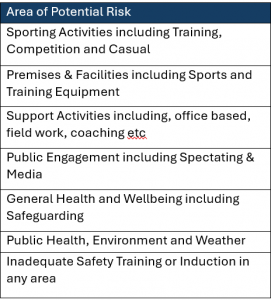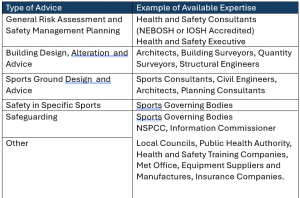The Diverse Nature of Sporting Activities, Club Arrangements, Facilities, Premises, Equipment, Staff/Volunteer/Spectator roles and profiles, as well as informal casual groups of sporting organisers and participants, makes it impossible to specify a ‘one size fits all’ set of Legislative Safety Requirements.
There are however some general principles that can be considered for all scenarios. Responsibilities and the need for written safety planning, procedures and records increase significantly in law if staff are employed to support the delivery of Sport but this does not exclude responsibilities to Volunteers, Participants and Spectators.
Safety Legislation exists to require ALL individuals and organisations to TAKE RESPONSIBILITY for Safety and Wellbeing and put sufficient resource into pre-planning, publicising, training, monitoring and improving procedures so that the risk of harm to people taking part in organized activities, as well as those affected by the activities, is minimized.
The sheer volume of Safety Legislation and Guidance Publications relating to a wide range of Risk Areas can be bewildering but these publications are generally produced in the forms shown in the table below.
(Note: This list is for illustration purposes only and should not be used as the sole basis for H&S Planning)
General Acts of Parliament
For Example
- Health and Safety at Work (Northern Ireland) Order 1978
Statutory Instruments
For Example
- Management of Health and Safety at Work Regulations (Northern Ireland) 2000
Approved Codes of Practice
For Example
- Workplace Health, Safety and Welfare
Health & Safety Executive Guidance Notes
For Example
- Health and Safety in Swimming Pools,
- Running Safe Sports Clubs
Sports Governing Body Policies & Guidelines (& Match Rules which encourage safer play)
For Example
- Match or Competition Rules
- Safeguarding Requirements
- Safe Coaching Requirements
- Concussion Guidelines etc
Insurance Company requirements
- Insurance Companies may require specific Health and Safety Procedures, Training, Monitoring and Records to guarantee cover in the Areas of Employers Liability, Premises, Public Liability, Volunteers cover etc
Suitable and sufficient Risk Assessments and good risk reduction and continuous improvement procedures are the cornerstone of reducing the risk of harm to people as well as protecting the liability of your organisation. The following general areas of risk may all have legislative requirements to consider depending on the scenario. No list is exhaustive and the following is only as an aid to consideration of Risk Profiles and sourcing expert advice.

